Recorder Digits History
What Was New In Version 2.68
- "Wide" message records, which use 2 screen positions, are available for use in external fingering files. They make large amounts of text appear in a nicer format on the screen, especially when combined with the linefeed capability introduced in 2.67.
- New versions of NORMTRIL.TXT, TURNTRIL.TXT, and LEARN.TXT, using the new wide message records for a better display (this is mainly apparent in LEARN.TXT). Also, TURNTRIL's report was improved by showing the actual note names on the report for each variation, instead of just reading "Full step above," etc.
- A completely reformatted version of the excerpts from Ken Wollitz's book "The Recorder Book" is also released at this time, taking full advantage of the wide records. The text from the book is much easier to read now. Go to the Ken Wollitz Advice page to see a screen snapshot of the new formatting and to download the new file.
- New keyboard navigation keys added: the numpad's number keys select the octave; the numpad's Plus and Minus keys select a note a half step up or down from the current note; the R key toggles External ReadMe display on and off, if present.
- The V (Version) Record, allowing fingering files to specify a minimum version of Recorder Digits required to display the file properly.
- Fixed the documentation for Using Bitmaps on F Records to reflect the fact that ";bmp=" must be in lowercase.
What Was New In Version 2.67
- It is now possible to position the system cursor within a text message on the display and make the message scroll. This allows the viewing of messages that do not fit within the area because the system font is large. It also allows copying the message to the system clipboard.
- Similarly, it is now possible to position the system cursor within the Message Field at the bottom of the screen. This allows the viewing of messages that are too wide to fit in the Message field area, by making the text scroll at the right side of the area when the cursor is moved to the right. It also allows copying the text to the clipboard.
- The Text portion of the InfoBox (obtained by doubleclicking an Info button) can also have the system cursor placed within it for scrolling and/or copying.
- It is now possible for External file F-Message records to have linefeeds (line breaks) in them, using the new variable %n .
What's Was New In Version 2.65
- A new Enharmonics Menu item, which allows users to pick how the program will display enharmonic note names. Here is a full-size screen snapshot of the new Enharmonics Menu:
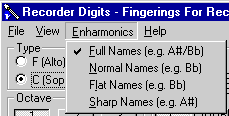
You can see how it changes the display by looking at the snapshot of NORMTRIL.TXT.
- A new entry on the Preferences dialog to allow the user to pick the Enharmonics setting at program startup.
- A new version of NORMTRIL.TXT, which uses the new Label F Record to create a more pleasing appearance.
- For external fingering file authors, 2 new varieties of Text Variables are available, to override the user's enharmonic names setting (these should only be used in special circumstances).
What Was New In Version 2.60
- A new Preferences dialog has been added, allowing you to set the startup settings of the program - Recorder Type (alto, soprano, bass), Octave, and Display Trills setting.
Here is a full-size screen snapshot of the new Preferences Dialog (reached via the File/Preferences menu item):
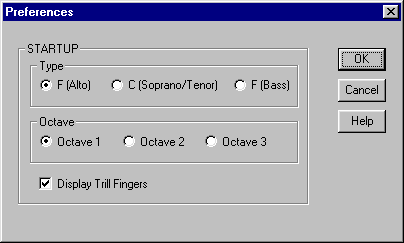
- All supplied external files have had their Recorder Type record removed (commented-out). This makes the Recorder Type setting established in Preferences stay in effect even when an external file is loaded.
What Was New In Version 2.52
- A new external fingering file, TURNTRIL.TXT, is now supplied
with the program. It shows all flavors of turned trills (4 note
combinations) for all notes. Read about it here.
- The keyboard keys PageDown and PageUp now perform the same functions as the FWRD and BACK buttons. This is especially helpful with the new TURNTRIL.TXT, which has 4 pages per note.
- New entries on the File menu make it easy to load the 3 supplied external fingering files (NORMTRIL.TXT, LEARN.TXT, and TURNTRIL.TXT). Here is a snapshot of the new menu:
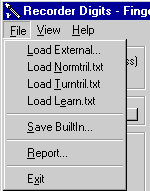
- For external file development, several new features have been implemented. New versions of NORMTRIL.TXT and LEARN.TXT take advantage of some of these new features. For more information, see the README.TXT file that comes with the program and also the program's help.
What Was New In Version 2.50
- Doubleclicking an Info button will bring up the new InfoBox, a separate box which displays the fingering plus the Info text in a larger font. Here is a full-size screen snapshot of the new InfoBox:
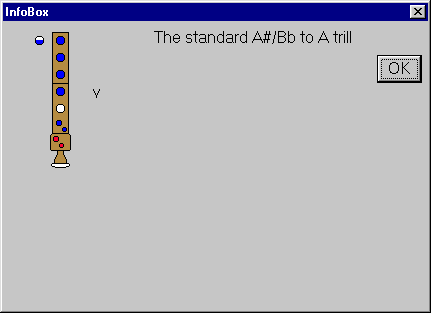
- External fingering files can now use "Screen-Only" fingering records - records that will appear on the screen display but will not appear on any report that is produced. New versions of NORMTRIL.TXT and LEARN.TXT (supplied in the download) now take advantage of this new feature.
- The display problems that the program had with systems that use the Large Font setting has been corrected.
What Was New In Version 2.42
- External fingering files can now use "Report-Only" fingering records - records that will not appear on the screen display but will appear on any report that is produced.
The new external file containing Fingering Advice From Ken Wollitz uses this new feature, so you should upgrade to version 2.42 to take full advantage of the Wollitz file (although it will display on the screen correctly even with 2.40).
What Was New In Version 2.40
- The program now uses "smart" text that takes into account the
type of recorder being displayed - i.e. alto, bass or
soprano/tenor.
For example, on the Info button for an Octave 2 fingering, the prior version displayed (regardless of the recorder type):
"The standard A(E) to G(D) trill..."
Version 2.40 displays (when the recorder type is alto or bass):
"The standard A to G trill..."
or (when the recorder type is soprano/tenor):
"The standard E to D trill..."This is accomplished through the use of "text variables," which are designed to improve the display of text that mentions notes by name by eliminating the clumsy double specification of both F-notation and C-notation names.
Text variables can also be used in external fingering files. New versions of the supplied external files NORMTRIL.TXT and LEARN. TXT use this new feature.
- Improved the F1 Help facility. It now displays help about Menu items if a menu item was the last thing used.
What Was New In Version 2.33
- This is a minor update. To help distinguish External ReadMe mode (i.e. when External ReadMe info is being displayed), the note buttons are greyed and the scale is not shown.
- Added a Frequently Asked Question section to the Help system.
What Was New In Version 2.32
- The keyboard can now be used to navigate octaves and notes (e.g. pressing the "2" key selects Octave 2; pressing the "g" key selects note g).
- Modified Octave 1, Note E - added a trill finger to one alternate thereby giving a nice alternate F to E trill), and rearranged other alternates. This is the same change made to this website on 04/09/01 (click here to view the trills for that note).
- The Supplied file - NORMTRIL.TXT was modified to add the alternate F to E trill mentioned above. A bitmap image is used to show an example of where this alternate trill might be useful (the screen snapshot of NORMTRIL shown here shows that screen).
What's Was New In Version 2.30
- Version 2.30 adds a new menu item File->Report, allowing users to produce a text report file of the fingerings displayed by the program. One use for this new feature is to then take the resulting text file, load it into a word processor or text editor, and print it.
What Was New In Version 2.21
- Version 2.21 is a maintenance release. It fixes a small bug which caused the External ReadMe button to disappear after a File->SaveBuiltin. The size of the Help file was reduced by decreasing the number of colors in its BMP files, and the installation zip file size was reduced by decreasing the colors in the BMP files used by NORMTRIL.TXT and LEARN.TXT
What Was New In Version 2.20
- External files can now display graphics (.bmp files). A good example is the following screen snapshot of the supplied NORMTRIL.TXT file's ReadMe screen:
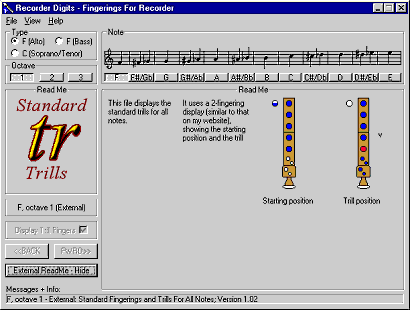
- A new external file, LEARN.TXT is now supplied. Click here for more info.
- The maximum text length for fingering records (in External files) has been increased from 120 characters to 200 characters.
- Fixed an error in the built-in fingerings that prevented the explanatory text for an alternate for octave 3 F#/Gb from appearing. This alternate and explanation are valuable for playing Brandenburg Concerto #4.
What's New In Version 2.11
Version 2.11 is a maintenance release which fixes a problem that prevented the program from displaying correctly on some systems.
Also included are changes to the Builtin-fingerings and the NORMTRIL.TXT external file. These implement the change made to this website on 5/12/00 - a new alternate trill for octave 2 Db to B. Click here to view.
What's New In Version 2.10
Version 2.10 adds several capabilities to External Files. The most important is the ability of External Files to have "ReadMe" documentation associated with them that gets loaded along with the file and can then be viewed by the user.
Another new feature is the ability for a fingering to specify that the windway should be partially covered ("shaded").
What's New In Version 2.00
The big news in Version 2 is the ability to Load external fingering files. The program is no longer limited to displaying only the fingerings that are built-in. This gives any user the ability to change the fingerings that the program displays. Additionally, it is hoped that people will create fingering files and distribute them for use with the program. For example, a person could create a file with the fingerings specific to a particular model of recorder.
Version 2 comes supplied with one external file, NORMTRIL.TXT. This file provides normal trill fingerings for all notes (Click here for a screen snapshot after the file has been loaded).